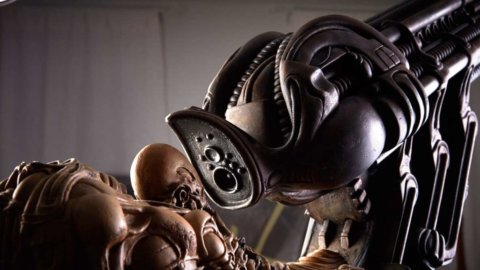An incredible collection of rarities such as the Apollo 11 cosmogram signed by Armstrong, Aldrin and Collins, the space suit of Jean-Loup Chrétien (the first Western European man to go into space), the Space Jockey (the pilot of the derelict spaceship from the films Alien and Prometheus) by HR Giger (creator of Alien), an edition of Orlando Furioso from 1607: here are some of the extraordinary protagonists of the exhibition "Journey into the Cosmos", organized by the Hermann Geiger Cultural Foundation in its spaces exhibition halls, in piazza Guerrazzi 32, in Cecina. The exhibition, with free admission and scheduled from 3 December to 19 February 2017 (hours: 16-20; opening at 17), is a journey to discover the Universe, understood as a real place and as a frontier of the fantastic, winds through ancient and modern scientific instruments, celestial maps, literary, artistic and cinematographic works.
The exhibition opens with an overview of the history of astronomy, illustrating the discovery of space from the sixteenth to the late nineteenth century both through scientific devices (such as, for example, a seventeenth-century telescope for observing the stars, Ptolemaic and Copernican armillary spheres, a Newtonian telescope etc.) and artistic objects (including a seventeenth-century statue of Atlas and a nineteenth-century canvas depicting the astronomer Archimedes).
A section follows which illustrates, through books, comics, film posters and toys, how much the cosmos in general and the Moon in particular have inspired cinema, literature and art; moreover, Le voyage dans la Lune by Georges Méliès, one of the first and best known science fiction films, dating back to 1902, is projected. The exhibition is also enriched with works by contemporary artists, such as the Swiss François Junod, specialized in the construction of automata , and the Livornese Stefano Pilato, who makes his creations strictly with recycled material.
The exhibition hall on the ground floor ends with a space dedicated to music, where you can listen to a wide selection of musical pieces inspired by the stars and the universe, as well as a selection of real "space sounds".
On the first floor materials are exhibited that illustrate the effective conquest of space and the discoveries made possible by contemporary science in the starry sky and beyond. In this area objects relating to the moon landing are exhibited (for example the copy of "Life" from 1969, relating to the landing), as well as unique and very rarely visible pieces, such as a precious copy of the novel De la Terre à la Lune by Jules Verne signed by eighteen astronauts and the famous congratulatory telegram sent by Khrushchev to Gagarin in 1961.
In a second section an important selection of meteorites is presented (the oldest piece dates back to 1492) and a part of the room is dedicated to the display of a spark chamber and an interferometer, instruments that will allow spectators to "see" with their eyes how the most authoritative and current research contributes to outline the structure of the universe.
The exhibition concludes with a cinema room in which scientific documentaries concerning the structure of the universe and the solar system are projected, and which will include a surprise "game" for the most curious visitors.
As always, the Geiger Foundation has taken care of the planning and realization of this twenty-fifth exhibition, creating a catalog which, in addition to presenting the exhibited pieces with detailed photos and fact sheets, offers space for important scientific contributions. Everything is totally free for the public, in the full spirit of the Foundation, which promotes, on the territory and beyond, the diffusion of culture as an instrument of freedom and emancipation.
The exhibition sees the collaboration of authoritative international bodies such as the National Institute of Nuclear Physics, the EGO Observatory of Cascina (PI), the HR Giger Museum of Gruyères and the Maison d'Ailleurs of Yverdon-les-Bains in Switzerland, the 'BOLAFFI Historical Archive of Philography and Communication and the MUFANT – MuseoLab of Fantastic and Science Fiction, both in Turin. Many objects also come from important private collectors: Piero Gondolo della Riva, vice president of the Société Jules Verne in Paris; Fausto Casi, scientific director of the Museum of the Means of Communication in Arezzo; Matteo Chinellato, the greatest Italian collector of meteorites.
On the occasion of the "Journey into the Cosmos" exhibition, the Foundation will present a rich calendar of initiatives on the subject, proposing a cycle of conferences and meetings that will range from the latest scientific discoveries to cinema and a series of guided visits to the Punta Falcone Observatory in Piombino.





